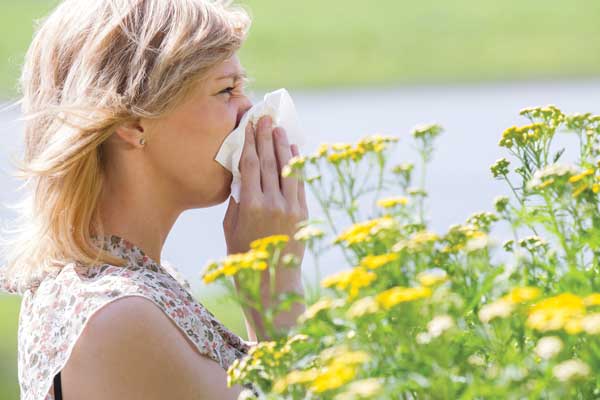By Sanaz Majd, MD
The Spring season brings with it our most beloved Iranian holiday of the year, Nowruz. But it also means allergy season for many. Although environmental allergies can occur year-round or episodically, seasonal allergies during these months are a common time for flare ups, as pollen counts are often high, the grass is fresh, the flowers are blooming, and people are spending more time outside. In this article, we will be discussing environmental allergies, specifically those in the adult population.

SYMPTOMS:
Mild allergies are common and people may go undiagnosed for years without them causing any distress. And if so, nothing necessarily needs to be done about them. But for others, the symptoms can be more severe, more frequent, or may impair quality of life. These symptoms often include:
• Runny nose
• Stuffy nose
• Sneezing
• Itchy, watery eyes
• Post-nasal drip
• Cough
COMPLICATIONS:
A persistent cough is often caused by either irritation of the upper airways, especially in those with concomitant asthma, but more frequently from chronic post-nasal drip caused by allergies. However, a persistent cough is a symptom that should never be ignored as it can be caused by numerous other conditions and really requires a doctor’s evaluation.
If an allergy is severe enough, angioedema (lip swelling) and life-threatening anaphylaxis (throat swelling) are more serious concerns, although not very common. People who experience these conditions may benefit from seeing an allergist. Although environmental allergies less commonly cause these conditions as compared to allergies due to ingested food and medications (such as antibiotics).
DIAGNOSES:
The diagnosis of environmental allergies is often based on symptoms and a simple exam in the office. Most people with allergies do not require any further diagnostic testing. Blood tests to check the antibodies to various environmental allergens are available, however they are not always helpful due to false negative results. The tests are often very costly, too, and not guaranteed to be covered by insurance. However, they may offer answers for people who have severe, more debilitating symptoms and/or those who have experienced angioedema or anaphylaxis as a result of an allergic reaction.
In addition, skin patch testing can be done by an allergist for more severe allergies. Here, they apply various “allergens” (such as grass, pollen, etc.) onto the skin to determine if a reaction occurs (such as a rash).
TREATMENTS:
Of course, the most obvious treatment of allergies is to avoid the allergen itself. So, if you know you are allergic to grass, skip the picnics. If you are allergic to pet dander, don’t get a dog. If you can avoid the trigger, you can control the symptoms. Note that the goal of treatment is to reach satisfactory control of the symptoms and not necessarily a complete resolution. Most allergies are not curable, but are controllable.
Most treatments for allergies are, thankfully, available over-the-counter (OTC) now, but often leave people confused as there are numerous options on the shelf. The first thing to note when viewing the medication package is the generic name for the drugs—these are often listed right below the brand name on the front cover and/or are listed as the “active ingredient” on the panel. So, for instance, the OTC drugs marketed as “Allertec” at Costco and “Allergy Relief” at CVS are both really the same drug—cetirizine. The brand name for cetirizine is called “Zyrtec,” but all three drugs are essentially the same. Purchase the least costly one as there is no need to get the expensive brand.
Antihistamines:
Examples of antihistamines include diphenhydramine (Benadryl) and chlorphenirarmine (Chlor-Trimeton). They are shorter-acting, lasting a few hours and often causing drowsiness. For this reason, sometimes people cannot tolerate them during the daytime. As a result, this group of drugs is often not recommended for those over the age of 65. They also can trigger restless leg syndrome exacerbations, a condition in which there is a persistent urge to move the legs at nights and interfere with sleep.
Be careful of some of the “cough & cold” concoctions that are available OTC, such as Nyquil/Dayquil, as many of them include several active drugs and very often one of them is an antihistamine. The nighttime formulations often include one of these ingredients as they are sedating.
Non-drowsy Antihistamines:
Examples of non-drowsy antihistamines include cetirizine (Zyrtec), loratidine (Claritin), and fexofenadine (Allegra). Even though they are marketed as “non-drowsy,” there are a subset of people who still find them somewhat sedating. But this group is definitely less so than the previously listed antihistamines. They last longer than traditional sedating antihistamines, often up to 24 hours, and are taken once daily.
Intranasal Steroids:
Examples of intranasal steroids include fluticasone (Flonase) and mometasone (Nasonex). Now available OTC, they are used to treat post-nasal drip. However, they are rather ineffective if used only “as needed”—they start to take effect after a week or two of daily use and must be continued daily for maintenance. However, most people whose allergies are seasonal may only need to use them for a few months out of the year. In addition, they do require a special technique for full efficacy and do not work as well if used incorrectly. I have created a YouTube video demonstrating their use on my channel @MajdMD if you are unsure. Otherwise, make certain to read the instruction sheet that accompanies the product.
Decongestants:
Decongestants help alleviate nasal congestion. Phenylephrine is the main one included in most products on the shelf and is a tad weaker. Pseudoephedrine is the more potent version, but it is kept behind the shelf; it is available without prescription, but the pharmacist must dispense it.
Decongestants are not meant to be used on a chronic basis; they are only for short-term or as-needed use. Some people cannot tolerate them, as they can increase heart rate and blood pressure in those who are prone.
Eye Drops:
There are various OTC eye drops used to treat “allergic conjunctivitis,” the itchy/watery eyes symptom caused by allergies. Examples include olopatadine (Pataday) and ketotifen (Zaditor), which are topical antihistamines for the eye.
Prescription Alternatives:
Most people with mild/moderate allergies do not require prescription alternatives. However, there are a few options if symptoms are more severe or do not respond sufficiently to OTC options, such as:
Montelukast (Singulair)
Azelastine nasal spray
Prescription eye drops, such as nedocromil (Alocril)
Oral antihistamines, such as hydroxyzine and cromolyn sodium
For those people who do not find sufficient relief with medications and whose symptoms are more severe, immunotherapy is an option which often involves injections managed by an allergist. It typically requires a long term commitment, however, with weekly injections for months to even years.
Now, hopefully you no longer need to dread the Spring months and can instead enjoy this beautiful season. Wishing you a healthy (always first) and happy Nowruz.
Sanaz Majd, MD is a board-certified Family Medicine physician and host of the Majd MD YouTube channel (@Majd MD), reviewing the latest medical topics and headlines. You can also follow her on Facebook or Instagram: @SMajdMD.


















